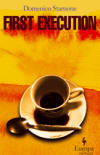First Execution
On the surface, First Execution by Domenico Starnone is a novel about terrorism, filled with the requisite twists and turns that are the driving force of a crime thriller. Yet, it’s also a metafictional narrative reminiscent of Calvino’s If on a Winter’s Night a Traveler, becoming a text on the act of writing and editing, switching from protagonist to author, and back again.
On the surface, First Execution by Domenico Starnone is a novel about terrorism, filled with the requisite twists and turns that are the driving force of a crime thriller. Yet, it’s also a metafictional narrative reminiscent of Calvino’s If on a Winter’s Night a Traveler, becoming a text on the act of writing and editing, switching from protagonist to author, and back again.
The story begins when Domenico Stasi, a sixty-seven year old retired professor from Naples, receives a phone call from a former student, Nina. She’s been arrested for conspiracy and needs his help in finishing the job. Professor Stasi taught during the height of the Red Brigades’ terrorization of Italy during the 1970s, lecturing heavily about Communism, and urging his students to partake in the Revolution. Helping Nina could be his chance to literally practice what he preached. She asks him to locate The Death of Virgil in a friend’s empty apartment, transcribe a phrase on page 46 and await further instructions.
After the professor finds the book, the author intervenes. He ponders using a different quotation from the book, he cuts out passages and then adds them back in, he imagines that the professor never found the book, but instead headed home empty handed. The author also reflects on himself, wondering whether he is a good person. He says:
I had always had within me, ever since I was quite small, a violence that was constantly on the verge of exploding, a lust for mayhem that I had learned quite young to repress, keeping tamped down my feelings of rage, my aggressive instincts, my treachery, my evil. In other words, if I was good, I was good only in the sense that I had succeeded in imprisoning my inborn ferocity.
This attitude parlays into the complexities of Professor Stasi’s character, the repressed anger, the hidden aggression; he’s an educator on acts of violence who is unable (or unwilling?) to carry them out himself. Many writers use aspects of themselves in their work and the author admits to “constructing the story . . . [and] reinventing my experience.”
Throughout First Execution, Starnone deftly explores the dangerous violence that lurks within the author and the professor, exposing the terrors that lay within the human mind, always threatening to rise toward the surface. Will professor Stasi become submerged in a misguided act of bloodshed? Will the author? Be prepared to unpack the layers in this gem of European noir. For those desiring a bit more depth to their standard crime fiction, this intelligent thriller is worth checking out.





